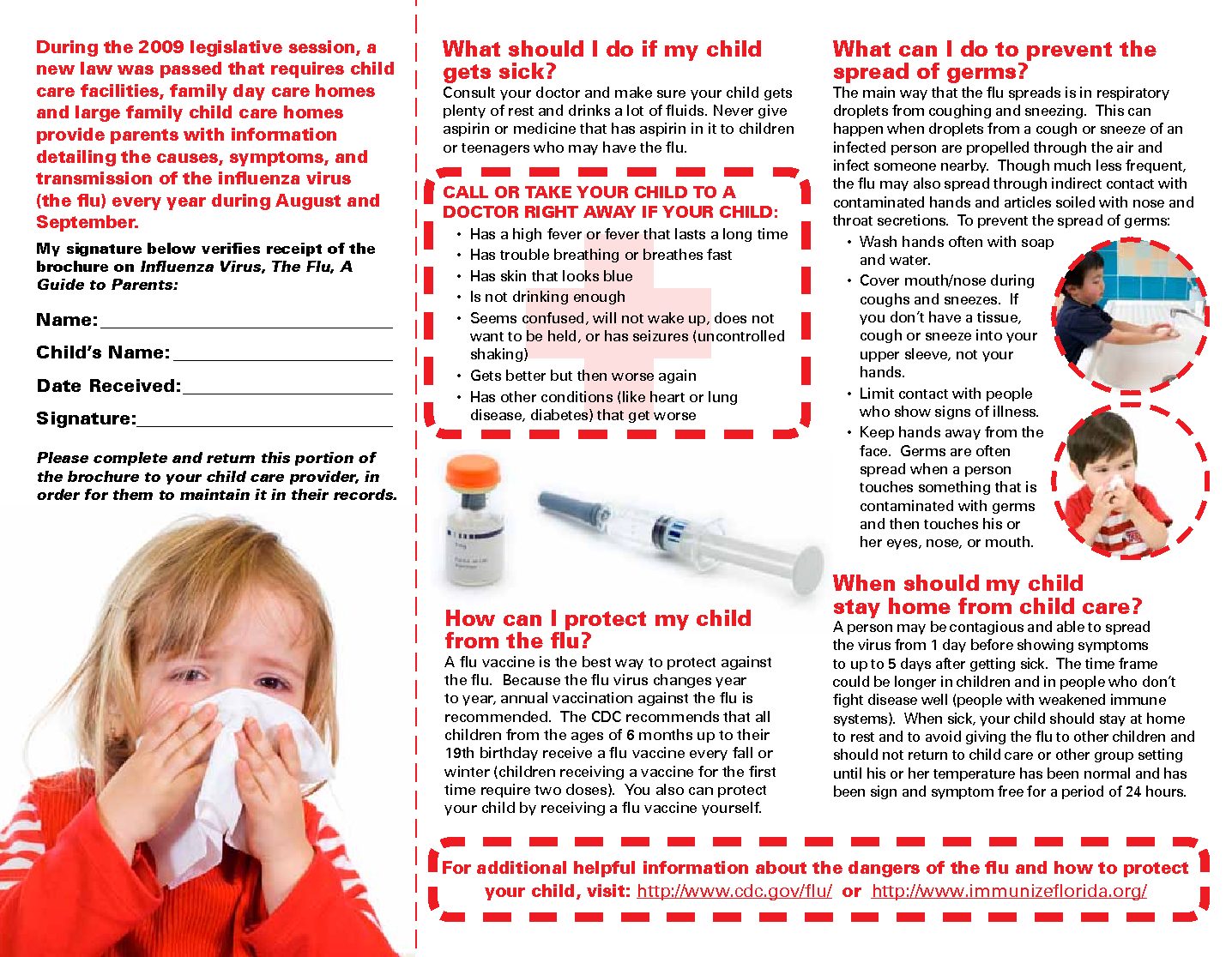INFLUENZA
The dangers of the flu and how to protect your child
During the 2009 legislative session, a new law was passed that requires child care facilities, family day care homes and large family child care homes provide parents with information detailing the causes, symptoms, and transmission of the influenza virus (the flu) every year during August and September.
Please read the following info and download the form posted below.
For additional helpful information about the dangers of the flu and how to protect your child, visit: http://www.cdc.gov/flu/ or http://www.immunizeflorida.org/
Influenza (“the flu”) is caused by a virus which infects the nose, throat, and lungs. According to the US Center for Disease Control and Prevention (CDC), the flu is more dangerous than the common cold for children. Unlike the common cold, the
flu can cause severe illness and life threatening complications in many people. Children under 5 who have the flu commonly need medical care. Severe flu complications are most common in children younger than 2 years old. Flu season can begin as early as October and last as late as May.
Most people with the flu feel tired and have fever, headache, dry cough, sore throat, runny or stuffy nose, and sore muscles. Some people, especially children, may also have stomach problems and diarrhea. Because the flu and colds have similar symptoms, it can be difficult to tell the difference between them based on symptoms alone. In general, the flu is worse than the common cold, and symptoms such as fever, body aches, extreme tiredness, and dry cough are more common and intense. People with colds are more likely to have a runny or stuffy nose. Colds generally do not result in serious health problems, such as pneumonia, bacterial infections, or hospitalizations.
Consult your doctor and make sure your child gets plenty of rest and drinks a lot of fluids. Never give aspirin or medicine that has aspirin in it to children or teenagers who may have the flu.
Call or take your child to a doctor right away of your child:
• Has a high fever or fever that lasts a long time
• Has trouble breathing or breathes fast
• Has skin that looks blue
• Is not drinking enough
• Seems confused, will not wake up, does not want to be held, or has seizures (uncontrolled shaking)
• Gets better but then worse again
• Has other conditions (like heart or lung
disease, diabetes) that get worse
A flu vaccine is the best way to protect against the flu. Because the flu virus changes year to year, annual vaccination against the flu is recommended. The CDC recommends that all children from the ages of 6 months up to their 19th birthday receive a flu vaccine every fall or winter (children receiving a vaccine for the first time require two doses). You also can protect your child by receiving a flu vaccine yourself.
The main way that the flu spreads is in respiratory droplets from coughing and sneezing. This can happen when droplets from a cough or sneeze of an infected person are propelled through the air and infect someone nearby. Though much less frequent, the flu may also spread through indirect contact with contaminated hands and articles soiled with nose and throat secretions.
To prevent the spread of germs:
• Wash hands often with soap and water.
• Cover mouth/nose during coughs and sneezes. If you don’t have a tissue, cough or sneeze into your upper sleeve, not your hands.
• Limit contact with people who show signs of illness.
• Keep hands away from the face. Germs are often spread when a person touches something that is contaminated with germs and then touches his or her eyes, nose, or mouth.
A person may be contagious and able to spread the virus from 1 day before showing symptoms to up to 5 days after getting sick. The time frame could be longer in children and in people who don’t fight disease well (people with weakened immune systems).
When sick, your child should stay at home to rest and to avoid giving the flu to other children and should not return to child care or other group setting until his or her temperature has been normal and has been sign and symptom free for a period of 24 hours.

